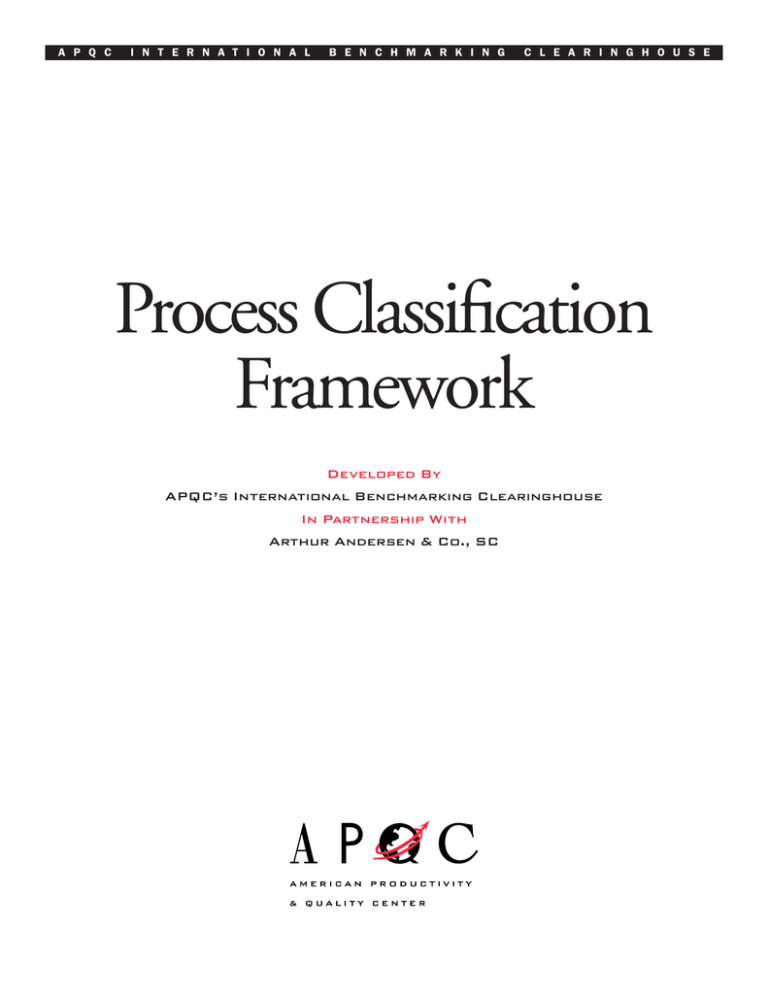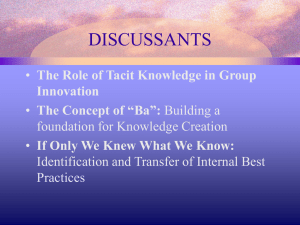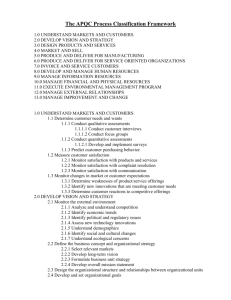
A P Q C
I N T E R N A T I O N A L
B E N C H M A R K I N G
C L E A R I N G H O U S E
Process Classification
Framework
Developed By
APQC’s International Benchmarking Clearinghouse
In Partnership With
Arthur Andersen & Co., SC
MANAGEMENT & SUPPORT PROCESSES
O P E R AT I N G P R O C E S S E S
Process Classification Framework: Overview
1.
Understand
Markets &
Customers
2.
Develop
Vision &
Strategy
3.
Design
Products &
Services
4.
Market
&
Sell
5.
Produce &
Deliver for
Manufacturing
Organization
6.
Produce &
Deliver for
Service
Organization
7.
Invoice &
Service
Customers
8. Develop and Manage Human Resources
9. Manage Information
10. Manage Financial and Physical Resources
11. Execute Environmental Management Program
12. Manage External Relationships
13. Manage Improvement and Change
About the Framework
The Process Classification Framework has been developed
over the past three years by the APQC International
Benchmarking Clearinghouse, with the assistance of several
major international corporations, and in close partnership
with Arthur Andersen & Co.
The intent has been to create a high-level, generic
enterprise model that will encourage businesses and other
organizations to see their activities from a cross-industry
process viewpoint instead of a narrow functional viewpoint.
Many organizations now have used the Process
Classification Framework in practical ways to better
understand their processes, to reach out across industry
boundaries to communicate and share information, and to
classify information in various forms.
Process Classification Framework
PURPOSE
The Process Classification Framework serves as a high-level,
generic enterprise model that encourages businesses and other
organizations to see their activities from a cross-industry process
viewpoint instead of from a narrow functional viewpoint.
All too often, organizations become bogged down by the fear of
making mistakes in “apples to oranges” benchmark comparisons. Convinced that they have unique characteristics and
constraints, they have difficulty understanding how to compare their processes meaningfully to those of other, different
organizations.
However, experience shows that the potential of benchmarking
to drive dramatic improvement often lies squarely in making
“out of the box” comparisons and a search for insights not
found within typical intra-industry paradigms.
How can organizations communicate effectively across industry boundaries and overcome the vocabularies that obscure the
underlying commonality of their business processes?
The Process Classification Framework supplies a generic view of
business processes often found in multiple industries and
sectors—manufacturing and service, healthcare, government,
education, and others.
Additionally, many organizations now seek to understand their
inner workings from a horizontal process viewpoint, rather
than from a vertical functional viewpoint. How can they, for
example, differentiate the sales process from the existing sales
department?
The Process Classification Framework seeks to represent major
processes and subprocesses, not functions, through its structure and vocabulary. The Framework does not list all processes
within any specific organization. Likewise, not every process
listed in the Framework is present in every organization.
HISTORY
The Process Classification Framework was originally envisioned
as a “taxonomy” of business processes during the 1991 design of
the American Productivity & Quality Center’s International
Benchmarking Clearinghouse.
That design process involved more than 80 organizations with
a strong interest in advancing the use of benchmarking in the
U.S. and around the world. A primary issue was, and continues
to be, how to nurture and enable process benchmarking across
industry boundaries.
The founding members of the Clearinghouse were convinced
that a common vocabulary, not tied to any specific industry,
was necessary to classify information by process and to help
companies transcend the limitations of “insider” terminology.
A small team, representing both industry and APQC, held the
initial design meetings in early 1992. APQC published the
first version of the Framework later that year.
C O L L A B O R AT I O N
APQC and Arthur Andersen & Co. have collaborated closely to
bring the Process Classification Framework to life and enhance
it over the past three years. The Center would like to acknowledge the staff of Arthur Andersen for their research and numerous insights during this effort.
Many other Clearinghouse member companies from diverse
industries have also contributed to the ongoing development of
the Framework.
L O O K I N G F O R WA R D
Continuing dialogue with Clearinghouse members has shown
that the Processes Classification Framework can be a useful
tool in understanding and mapping business processes. In particular, a number of organizations have used the Framework
to classify both internal and external information for the purpose
of cross-functional and cross-divisional communication.
The Process Classification Framework is an evolving document. The Center will continue to enhance and improve it on
a regular basis. To that end, we welcome your comments, suggestions for improvement, and any insights you gain from
applying it within your organization.
Additionally, other process models exist in various forms; these
models might enhance the effectiveness of the Framework. We
would like to learn from anyone with such information to
share.
RIGHTS AND PERMISSIONS
© Copyright by the American Productivity & Quality Center.
All rights reserved.
APQC would like to see the Process Classification Framework
receive wide distribution, discussion, and use. Therefore, it
grants permission for copying the Framework, as long as
acknowledgement is made to the American Productivity &
Quality Center. Please notify and inform APQC concerning
your use or application.
Please direct your comments, suggestions, and questions to:
APQC International Benchmarking Clearinghouse
Information Services Dept.
123 North Post Oak Lane, 3rd Floor
Houston, Texas 77024-7797
713-681-4020 (phone)
713-681-8578 (fax)
Internet: apqcinfo@apqc.org
For updates, visit our Web site at http://www.apqc.org
© 1 9 9 6 I N T E R N AT I O N A L B E N C H M A R K I N G C L E A R I N G H O U S E
O P E R A T I N G
1. UNDERSTAND MARKETS AND CUSTOMERS
1.1 Determine customer needs and wants
1.1.1 Conduct qualitative assessments
1.1.1.1 Conduct customer interviews
1.1.1.2 Conduct focus groups
1.1.2 Conduct quantitative assessments
1.1.2.1 Develop and implement surveys
1.1.3 Predict customer purchasing behavior
1.2 Measure customer satisfaction
1.2.1 Monitor satisfaction with products and services
1.2.2 Monitor satisfaction with complaint resolution
1.2.3 Monitor satisfaction with communication
1.3 Monitor changes in market or customer expectations
1.3.1 Determine weaknesses of product/service offerings
1.3.2 Identify new innovations that meet customer needs
1.3.3 Determine customer reactions to competitive offerings
2. DEVELOP VISION AND STRATEGY
2.1 Monitor the external environment
2.1.1 Analyze and understand competition
2.1.2 Identify economic trends
2.1.3 Identify political and regulatory issues
2.1.4 Assess new technology innovations
2.1.5 Understand demographics
2.1.6 Identify social and cultural changes
2.1.7 Understand ecological concerns
2.2 Define the business concept and organizational strategy
2.2.1 Select relevant markets
2.2.2 Develop long-term vision
2.2.3 Formulate business unit strategy
2.2.4 Develop overall mission statement
2.3 Design the organizational structure and relationships between
organizational units
2.4 Develop and set organizational goals
3. DESIGN PRODUCTS AND SERVICES
3.1 Develop new product/service concept and plans
3.1.1 Translate customer wants and needs into product and/or
service requirements
3.1.2 Plan and deploy quality targets
3.1.3 Plan and deploy cost targets
3.1.4 Develop product life cycle and development timing targets
3.1.5 Develop and integrate leading technology into product/service concept
3.2 Design, build, and evaluate prototype products and services
3.2.1 Develop product/service specifications
3.2.2 Conduct concurrent engineering
3.2.3 Implement value engineering
3.2.4 Document design specifications
3.2.5 Develop prototypes
3.2.6 Apply for patents
3.3 Refine existing products/services
3.3.1 Develop product/service enhancements
PERMISSION GRANTED TO PHOTOCOPY FOR PERSONAL USE.
P R O C E S S E S
3.3.2 Eliminate quality/reliability problems
3.3.3 Eliminate outdated products/services
3.4 Test effectiveness of new or revised products or services
3.5 Prepare for production
3.5.1 Develop and test prototype production process
3.5.2 Design and obtain necessary materials and equipment
3.5.3 Install and verify process or methodology
3.6 Manage the product/service development process
4. MARKET AND SELL
4.1 Market products or services to relevant customer segments
4.1.1 Develop pricing strategy
4.1.2 Develop advertising strategy
4.1.3 Develop marketing messages to communicate benefits
4.1.4 Estimate advertising resource and capital requirements
4.1.5 Identify specific target customers and their needs
4.1.6 Develop sales forecast
4.1.7 Sell products and services
4.1.8 Negotiate terms
4.2 Process customer orders
4.2.1 Accept orders from customers
4.2.2 Enter orders into production and delivery process
5. PRODUCE AND DELIVER FOR MANUFACTURINGORIENTED ORGANIZATIONS
5.1 Plan for and acquire necessary resources
5.1.1 Select and certify suppliers
5.1.2 Purchase capital goods
5.1.3 Purchase materials and supplies
5.1.4 Acquire appropriate technology
5.2 Convert resources or inputs into products
5.2.1 Develop and adjust production delivery process
(for existing process)
5.2.2 Schedule production
5.2.3 Move materials and resources
5.2.4 Make product
5.2.5 Package product
5.2.6 Warehouse or store product
5.2.7 Stage products for delivery
5.3 Deliver products
5.3.1 Arrange product shipment
5.3.2 Deliver products to customers
5.3.3 Install product
5.3.4 Confirm specific service requirements for individual
customers
5.3.5 Identify and schedule resources to meet service
requirements
5.3.6 Provide the service to specific customers
5.4 Manage production and delivery process
5.4.1 Document and monitor order status
5.4.2 Manage inventories
5.4.3 Ensure product quality
5.4.4 Schedule and perform maintenance
5.4.5 Monitor environmental constraints
© 1 9 9 6 I N T E R N AT I O N A L B E N C H M A R K I N G C L E A R I N G H O U S E
PERMISSION GRANTED TO PHOTOCOPY FOR PERSONAL USE.
6. PRODUCE AND DELIVER FOR SERVICE-ORIENTED
ORGANIZATIONS
6.1 Plan for and acquire necessary resources
6.1.1 Select and certify suppliers
6.1.2 Purchase materials and supplies
6.1.3 Acquire appropriate technology
6.2 Develop human resource skills
6.2.1 Define skill requirements
6.2.2 Identify and implement training
6.2.3 Monitor and manage skill development
6.3 Deliver service to the customer
6.3.1 Confirm specific service requirements for individual
customer
6.3.2 Identify and schedule resources to meet service
requirements
6.3.3 Provide the service to specific customers
6.4 Ensure quality of service
M A N A G E M E N T
&
7. INVOICE AND SERVICE CUSTOMERS
7.1 Bill the customer
7.1.1 Develop, deliver, and maintain customer billing
7.1.2 Invoice the customer
7.1.3 Respond to billing inquiries
7.2 Provide after-sales service
7.2.1 Provide post-sales service
7.2.2 Handle warranties and claims
7.3 Respond to customer inquiries
7.3.1 Respond to information requests
7.3.2 Manage customer complaints
S U P P O R T
8. DEVELOP AND MANAGE HUMAN RESOURCES
8.1 Create and manage human resource strategies
8.1.1 Identify organizational strategic demands
8.1.2 Determine human resource costs
8.1.3 Define human resource requirements
8.1.4 Define human resource’s organizational role
8.2 Cascade strategy to work level
8.2.1 Analyze, design, or redesign work
8.2.2 Define and align work outputs and metrics
8.2.3 Define work competencies
8.3 Manage deployment of personnel
8.3.1 Plan and forecast workforce requirements
8.3.2 Develop succession and career plans
8.3.3 Recruit, select and hire employees
8.3.4 Create and deploy teams
8.3.5 Relocate employees
8.3.6 Restructure and rightsize workforce
8.3.7 Manage employee retirement
8.3.8 Provide outplacement support
8.4 Develop and train employees
8.4.1 Align employee and organization development needs
8.4.2 Develop and manage training programs
8.4.3 Develop and manage employee orientation programs
8.4.4 Develop functional/process competencies
8.4.5 Develop management/leadership competencies
8.4.6 Develop team competencies
8.5 Manage employee performance, reward and recognition
8.5.1 Define performance measures
8.5.2 Develop performance management approaches/feedback
8.5.3 Manage team performance
8.5.4 Evaluate work for market value and internal equity
8.5.5 Develop and manage base and variable compensation
8.5.6 Manage reward and recognition programs
P R O C E S S E S
8.6 Ensure employee well-being and satisfaction
8.6.1 Manage employee satisfaction
8.6.2 Develop work and family support systems
8.6.3 Manage and administer employee benefits
8.6.4 Manage workplace health and safety
8.6.5 Manage internal communications
8.6.6 Manage and support workforce diversity
8.7 Ensure employee involvement
8.8 Manage labor-management relationships
8.8.1 Manage collective bargaining process
8.8.2 Manage labor-management partnerships
8.9 Develop Human Resource Information Systems (HRIS)
9. MANAGE INFORMATION RESOURCES
9.1 Plan for information resource management
9.1.1 Derive requirements from business strategies
9.1.2 Define enterprise system architectures
9.1.3 Plan and forecast information technologies/methodologies
9.1.4 Establish enterprise data standards
9.1.5 Establish quality standards and controls
9.2 Develop and deploy enterprise support systems
9.2.1 Conduct specific needs assessments
9.2.2 Select information technologies
9.2.3 Define data life cycles
9.2.4 Develop enterprise support systems
9.2.5 Test, evaluate, and deploy enterprise support systems
9.3 Implement systems security and controls
9.3.1 Establish systems security strategies and levels
9.3.2 Test, evaluate, and deploy systems security and controls
9.4 Manage information storage & retrieval
9.4.1 Establish information repositories (data bases)
9.4.2 Acquire & collect information
9.4.3 Store information
© 1 9 9 6 I N T E R N AT I O N A L B E N C H M A R K I N G C L E A R I N G H O U S E
9.5
9.6
9.7
9.8
9.4.4 Modify and update information
9.4.5 Enable retrieval of information
9.4.6 Delete information
Manage facilities and network operations
9.5.1 Manage centralized facilities
9.5.2 Manage distributed facilities
9.5.3 Manage network operations
Manage information services
9.6.1 Manage libraries and information centers
9.6.2 Manage business records and documents
Facilitate information sharing and communication
9.7.1 Manage external communications systems
9.7.2 Manage internal communications systems
9.7.3 Prepare and distribute publications
Evaluate and audit information quality
10. MANAGE FINANCIAL AND PHYSICAL RESOURCES
10.1 Manage financial resources
10.1.1 Develop budgets
10.1.2 Manage resource allocation
10.1.3 Design capital structure
10.1.4 Manage cash flow
10.1.5 Manage financial risk
10.2 Process finance and accounting transactions
10.2.1 Process accounts payable
10.2.2 Process payroll
10.2.3 Process accounts receivable, credit, and collections
10.2.4 Close the books
10.2.5 Process benefits and retiree information
10.2.6 Manage travel and entertainment expenses
10.3 Report information
10.3.1 Provide external financial information
10.3.2 Provide internal financial information
10.4 Conduct internal audits
10.5 Manage the tax function
10.5.1 Ensure tax compliance
10.5.2 Plan tax strategy
10.5.3 Employ effective technology
10.5.4 Manage tax controversies
10.5.5 Communicate tax issues to management
10.5.6 Manage tax administration
10.6 Manage physical resources
10.6.1 Manage capital planning
10.6.2 Acquire and redeploy fixed assets
10.6.3 Manage facilities
10.6.4 Manage physical risk
PERMISSION GRANTED TO PHOTOCOPY FOR PERSONAL USE.
11. EXECUTE ENVIRONMENTAL MANAGEMENT
PROGRAM
11.1 Formulate environmental management strategy
11.2 Ensure compliance with regulations
11.3 Train and educate employees
11.4 Implement pollution prevention program
11.5 Manage remediation efforts
11.6 Implement emergency response programs
11.7 Manage government agency and public relations
11.8 Manage acquisition/divestiture environmental issues
11.9 Develop and manage environmental information system
11.10 Monitor environmental management program
12. MANAGE EXTERNAL RELATIONSHIPS
12.1 Communicate with shareholders
12.2 Manage government relationships
12.3 Build lender relationships
12.4 Develop public relations program
12.5 Interface with board of directors
12.6 Develop community relations
12.7 Manage legal and ethical issues
13. MANAGE IMPROVEMENT AND CHANGE
13.1 Measure organizational performance
13.1.1 Create measurement systems
13.1.2 Measure product and service quality
13.1.3 Measure cost of quality
13.1.4 Measure costs
13.1.5 Measure cycle time
13.1.6 Measure productivity
13.2 Conduct quality assessments
13.2.1 Conduct quality assessments based on external criteria
13.2.2 Conduct quality assessments based on internal criteria
13.3 Benchmark performance
13.3.1 Develop benchmarking capabilities
13.3.2 Conduct process benchmarking
13.3.3 Conduct competitive benchmarking
13.4 Improve processes and systems
13.4.1 Create commitment for improvement
13.4.2 Implement continuous process improvement
13.4.3 Reengineer business processes and systems
13.4.4 Manage transition to change
13.5 Implement TQM
13.5.1 Create commitment for TQM
13.5.2 Design and implement TQM systems
13.5.3 Manage TQM life cycle


